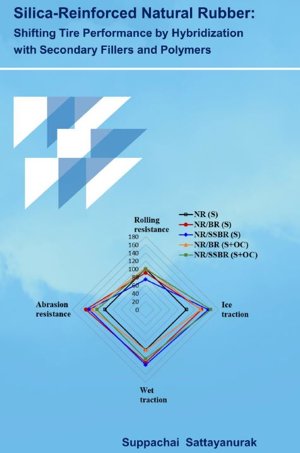On Friday, February 14th 2020, Mr. Suppachai Sattayanurak has successfully defended his PhD thesis entitled 'Silica Reinforced Natural Rubber: Shifting Tire Performance by Hybridization with Secondary Fillers and Polymers'.
SILICA-REINFORCED NATURAL RUBBER:
SHIFTING TIRE PERFORMANCE BY HYBRIDIZATION WITH SECONDARY FILLERS AND POLYMERS
 Silica-reinforced Natural Rubber (NR) offers modern tires with low rolling resistance and high wet traction indicative for fuel saving and safety, but insufficient abrasion resistance or tire durability. Therefore, the main goal of this project was to further enhance the key performances of silica truck tire tread compounds, especially abrasion resistance. This thesis covers hybrid filler compounds of silica with high specific surface area Carbon Black (CB) N134 or OrganoClay (OC) as secondary fillers as well as hybrid polymer compounds of NR with Butadiene Rubber (BR) or Solution Styrene Butadiene Rubber (SSBR) as secondary polymers. The silica/CB N134 combination gives an indication for a tire tread compound with improved ice and wet traction, respectively abrasion resistance but poorer rolling resistance. Whereas the silica/OC combination provides the indication of a tire tread compound with better rolling resistance and ice traction as well as a little improvement in wet traction and abrasion resistance. The combinations of silica/CB-filled NR/BR and NR/SSBR give an indication for tire tread compounds with a large improvement in ice and wet traction as well as abrasion resistance but on the other hand a large deterioration in rolling resistance. The use of the silica/OC-filled NR/BR combination offers the potential to enhance ice traction and abrasion resistance, with wet traction and rolling resistance remaining unchanged. Finally, the use of silica/OC-NR/SSBR shows the potential to improve ice and wet traction, and abrasion resistance with similar rolling resistance. So overall, the combination of OC and BR with silica-reinforced NR shows the best performance. The mechanistic details of these optimizations are highlighted in this thesis.
Silica-reinforced Natural Rubber (NR) offers modern tires with low rolling resistance and high wet traction indicative for fuel saving and safety, but insufficient abrasion resistance or tire durability. Therefore, the main goal of this project was to further enhance the key performances of silica truck tire tread compounds, especially abrasion resistance. This thesis covers hybrid filler compounds of silica with high specific surface area Carbon Black (CB) N134 or OrganoClay (OC) as secondary fillers as well as hybrid polymer compounds of NR with Butadiene Rubber (BR) or Solution Styrene Butadiene Rubber (SSBR) as secondary polymers. The silica/CB N134 combination gives an indication for a tire tread compound with improved ice and wet traction, respectively abrasion resistance but poorer rolling resistance. Whereas the silica/OC combination provides the indication of a tire tread compound with better rolling resistance and ice traction as well as a little improvement in wet traction and abrasion resistance. The combinations of silica/CB-filled NR/BR and NR/SSBR give an indication for tire tread compounds with a large improvement in ice and wet traction as well as abrasion resistance but on the other hand a large deterioration in rolling resistance. The use of the silica/OC-filled NR/BR combination offers the potential to enhance ice traction and abrasion resistance, with wet traction and rolling resistance remaining unchanged. Finally, the use of silica/OC-NR/SSBR shows the potential to improve ice and wet traction, and abrasion resistance with similar rolling resistance. So overall, the combination of OC and BR with silica-reinforced NR shows the best performance. The mechanistic details of these optimizations are highlighted in this thesis.
